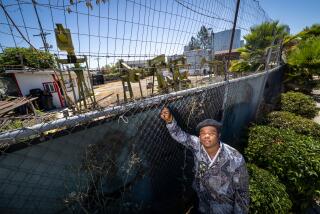18 and Growing--Greenpeace Comes of Age as Ecological Concerns Rise
AMSTERDAM — When 12 nature lovers painted “Greenpeace” on a rickety boat in 1971 and set sail to halt U.S. underground nuclear arms tests on a Pacific Ocean island, it was considered eccentric.
Eighteen years and scores of dramatic stunts later, Greenpeace is a robust organization at the forefront of environmental protection with a $75-million annual budget, 3 million members and offices in 21 nations.
“Respectability worries me,” said Steve Sawyer, executive director of Greenpeace International. “We have to be sure not to lose our cutting edge.”
Greenpeace moved its headquarters from London to Amsterdam this summer. The change, prompted by lower office rents, comes at a time when the organization is changing directions.
With politicians rushing to show their environmental credentials, Greenpeace’s role is shifting from maverick to responsible monitor in the fight to conserve nature.
“Ten years ago, no one knew what PCBs (polychlorinated biphenyls) were. Now all you have to do is say: ‘There’s this ship with nasty things aboard it,’ and people don’t want it in their port. We don’t have to blockade it,” he said.
“The dramatic actions we were once known for aren’t always necessary these days to bring things to people’s attention. Sometimes we can just point a finger and it’s enough,” Sawyer said.
Skillful Use of Media
The greater public awareness of pollution and environmental hazards is in part a tribute to the efforts of Greenpeace, which has skillfully used the media to advertise its cause.
An increasingly large part of Greenpeace’s budget goes to lobbying governments, the European Community and international organizations to take measures to protect the environment--and the organization now finds its ideas gain wide acceptance.
It has been a hard-won battle. Over the years, Greenpeace activists, often accompanied by camera crews or reporters, have risked arrest and even death.
They have weaved rubber dinghies alongside whaling vessels to stop the harpoons of hunters, scaled industrial chimneys to draw attention to polluters, chained themselves to nuclear waste dumping chutes and sprayed baby seals with green dye to prevent them from being killed for their white fur.
For years they have been a thorn to industrial polluters and governments testing nuclear weapons.
Ship Bombed and Sunk
Just how much of a thorn became clear in July, 1985, when the Greenpeace vessel Rainbow Warrior was blown up by French secret agents in New Zealand for protesting against French nuclear testing. A photographer on board drowned when the boat sank.
The attack only helped boost Greenpeace’s fame.
But the organization has not grown complacent. “There are still a lot of things that need to be brought to people’s attention,” Sawyer said.
Greenpeace still carries out its dramatic operations--a revamped Rainbow Warrior is to sail to the Pacific soon.
But it is also trying to expand operations. It has begun making inroads in the Third World, setting up an office in Argentina in 1987 and Costa Rica in 1988. It hopes to create a branch in Brazil, and it would like to open a Moscow office.
About 40% of its funding still goes to projects involving its seven vessels. But 15% goes to lobbying and information campaigns and 10% to research, usually farmed out to consultants.
2 Key Issues
Most recently, the organization has decided to concentrate its efforts on preservation of the Antarctic and to pressing for nuclear free seas.
In August, it unsuccessfully tried to block testing of the U.S. Trident submarine.
“We decided to start a campaign on this issue in 1987 because it was a part of the arms race which was out of the public eye. It was not under international control, and the scope for accidents is great,” Sawyer explained.
“People have to realize that the INF (Intermediate-range Nuclear Forces) Treaty doesn’t mean much if the missiles pulled out of Germany, the Netherlands and the United Kingdom go on submarines,” he said.
On the Antarctic, Greenpeace saw a chance to be a major actor in preserving humankind’s last wilderness.
“The Antarctic needs to be saved from exploitation of its mineral reserves. We had a sense that perhaps we could get in and save it before it got screwed up by humans,” Sawyer said.
The Antarctic has a major impact on the world’s weather and, its preservation is also important for base-line environmental impact studies, he explained.
Greenpeace has set up a base camp in the Antarctic--the only non-governmental group to do so--to monitor the area.
It also plans to intensify its fight against pollution of the atmosphere.
It continues in its more traditional fields--fighting for the preservation of sea animals and alerting the public to toxic chemicals and nuclear waste.
Sawyer is convinced that in the long run, Greenpeace’s message that people must change their ways to preserve the Earth will get across.
“The environment has to rise to the No. 1 issue on the world agenda. It’s getting there,” he said.
More to Read
Sign up for Essential California
The most important California stories and recommendations in your inbox every morning.
You may occasionally receive promotional content from the Los Angeles Times.









